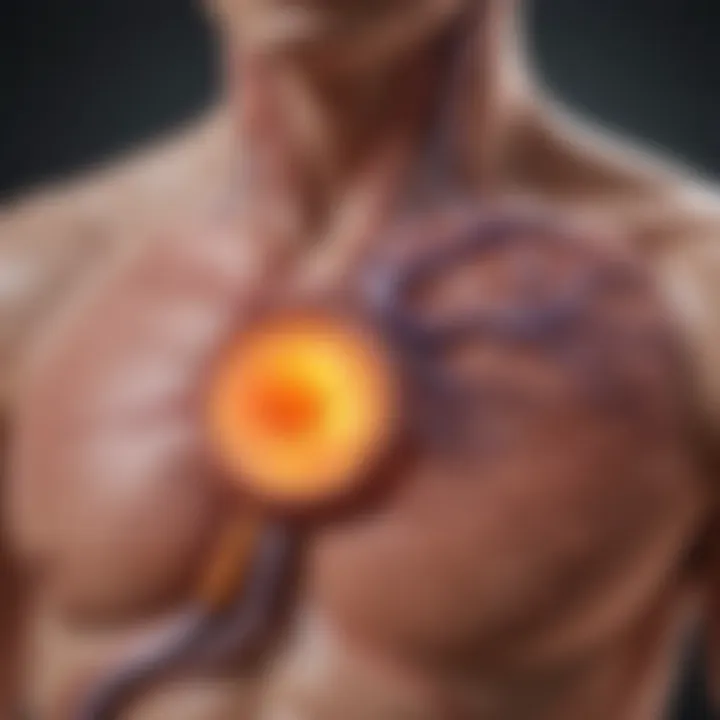Understanding High T Bilirubin Levels: Implications


Intro
Elevated T bilirubin levels present a multifaceted area of study within clinical medicine. Understanding the underlying mechanisms, diagnostic criteria, and consequences of high bilirubin is essential for healthcare professionals and researchers alike. This segment outlines the significance of bilirubin as a biomarker and emphasizes its role in assessing liver function and overall health.
Bilirubin is a yellow compound resulting from the breakdown of hemoglobin. Its metabolism involves the liver, which processes it into forms that can be excreted. When bilirubin levels in the blood rise, it can indicate various underlying health issues, ranging from liver disease to hemolytic conditions. The implications of these elevated levels can be profound, affecting patient management and treatment protocols.
This article aims to provide an in-depth look at the complexities surrounding high T bilirubin levels, clarifying pivotal findings and their relevance in both clinical and research settings.
Prolusion to Bilirubin
Bilirubin is an important biomarker in the medical field, reflecting various physiological and pathological processes in the body. Understanding bilirubin levels, especially elevated total (T) bilirubin, is crucial for healthcare professionals. High bilirubin levels can indicate a range of conditions, from simple physiologic variances to severe liver disease.
Bilirubin is a by-product of the body’s breakdown of heme, a component of red blood cells. The liver plays a central role in processing bilirubin, and any disruption in this process can lead to elevated bilirubin levels. This article seeks to unravel the complexities surrounding bilirubin metabolism, the implications of high T bilirubin levels, and the subsequent health impacts, alongside potential management strategies. An enhanced comprehension of these topics can lead to better diagnostic evaluation and treatment planning.
Definition and Function
Bilirubin is a yellow pigment formed when the body breaks down old red blood cells. The liver converts this pigment into a form that can be excreted. Bilirubin serves as a crucial indicator of liver function and health status. Its primary function is not just a waste product; it also reflects the effectiveness of heme degradation.
Types of Bilirubin
Bilirubin can be categorized into three main types: unconjugated, conjugated, and total bilirubin (T Bilirubin). Each of these types provides different insights into metabolic processes.
Unconjugated Bilirubin
Unconjugated bilirubin, also known as indirect bilirubin, is the form that results from heme breakdown before it is processed in the liver. This type is not water-soluble, which means it is carried in the bloodstream bound to albumin. The key characteristic of unconjugated bilirubin is that it is typically elevated in conditions related to increased hemolysis, such as hemolytic anemia. In the context of this article, understanding unconjugated bilirubin is vital as it highlights the processes leading to high T bilirubin levels. Its major disadvantage is that it can contribute to conditions like kernicterus in infants if not addressed.
Conjugated Bilirubin
Conjugated bilirubin, or direct bilirubin, is the form that has been processed by the liver. It is water-soluble, allowing it to be excreted via bile into the intestines. The prominent role of conjugated bilirubin is evident in cases of liver dysfunction, where its levels can rise significantly. It is a beneficial choice for the article as it directly relates to liver processes. The unique feature of conjugated bilirubin is that it can indicate bile duct obstructions or liver diseases. However, elevated levels often suggest more serious underlying health problems that require immediate attention.
T Bilirubin
Total bilirubin encompasses the sum of both unconjugated and conjugated bilirubin levels in the blood. This metric provides a comprehensive assessment of bilirubin metabolism. The significance of T bilirubin lies in its ability to represent both forms, making it a critical marker for diagnosing jaundice and liver dysfunction. The key characteristic of T bilirubin is its sensitivity to various pathologies. Understanding T bilirubin levels is crucial for this article as they can inform on the overall health of the liver and the effectiveness of bilirubin processing. A potential disadvantage is that it does not specify whether the elevation is due to hepatic, post-hepatic, or pre-hepatic causes.
High T Bilirubin: Definition and Thresholds
High T bilirubin levels serve as an important indicator of underlying health conditions. Understanding these levels is crucial for timely diagnosis and effective patient management. The appropriate interpretation of these values can significantly impact treatment decisions, making it essential for healthcare professionals to be well-versed in this area.
Normal vs. Elevated Levels
Bilirubin is a byproduct of heme breakdown, primarily occurring in the liver and spleen. Normal levels of total bilirubin (T bilirubin) typically range between 0.1 to 1.2 mg/dL. Values outside this range raise concern.
Elevated T bilirubin can indicate several issues, including liver dysfunction and hemolysis. When evaluating whether levels are elevated, clinicians focus on the cause and severity of the condition.
- Mild Elevation: Levels between 1.2 to 3.0 mg/dL may suggest early liver dysfunction or genetic issues like Gilbert’s syndrome.
- Moderate Elevation: Levels from 3.0 to 10.0 mg/dL usually warrant more extensive investigation. Conditions such as hepatitis or cholestasis might be underlying causes.
- Severe Elevation: Levels above 10.0 mg/dL often indicate serious liver injury or significant hemolysis affecting overall health.
Determining if levels are normal or elevated requires careful analysis of laboratory results along with clinical signs. A comprehensive evaluation ensures accurate diagnosis and better management outcomes.
Clinical Thresholds for T Bilirubin
Clinical thresholds are pivotal in assessing patient status. T bilirubin is categorized into unconjugated and conjugated forms, each with its own clinical implications.
The following thresholds are commonly referenced:
- Unconjugated Bilirubin: Normal ranges are 0.1 to 0.8 mg/dL. Levels exceeding 0.8 mg/dL may suggest conditions such as hemolytic anemia or Gilbert's syndrome.
- Conjugated Bilirubin: Typically ranges from 0 to 0.2 mg/dL. Levels exceeding this indicate potential biliary obstruction and liver disease.
Clinicians often interpret elevated T bilirubin values in light of other test results, demographic factors, and clinical history. This multifactorial approach aids in diagnosing conditions like liver cirrhosis or hepatocellular carcinoma. Understanding these clinical thresholds informs better decision-making in treatment plans.
Healthcare professionals must regularly update their knowledge of T bilirubin levels. This ensures timely identification of health risks and can lead to better patient outcomes.
Physiology Behind Bilirubin Production
Understanding the physiology behind bilirubin production is crucial in comprehending how elevated T bilirubin levels can affect overall health. Bilirubin serves as a key indicator of liver health and function. When bilirubin production and excretion are not balanced, it can lead to complications.
Heme Metabolism and Conversion
Heme metabolism is the first step in bilirubin production, stemming primarily from the breakdown of hemoglobin in red blood cells. Hemoglobin, which carries oxygen, has a life span of about 120 days before it is recycled by the body. Upon degradation, heme is converted into biliverdin, which is then rapidly reduced into unconjugated bilirubin. This form of bilirubin is lipid-soluble and not water-soluble, making it unable to be directly excreted by the kidneys.


The conversion of heme to bilirubin occurs primarily in the reticuloendothelial system, particularly in the liver and spleen. The efficiency of this process can be affected by various factors such as age, health, and the presence of certain diseases. When high levels of heme are present, such as in hemolytic anemia, an increased production of bilirubin occurs. This excess unconjugated bilirubin can lead to jaundice and other related conditions.
Liver's Role in Bilirubin Processing
The liver plays a critical role in the processing and excretion of bilirubin. After its formation, unconjugated bilirubin is transported to the liver, where it undergoes conjugation. During this phase, the liver cells add glucuronic acid to the unconjugated bilirubin, transforming it into conjugated bilirubin, which is water-soluble. This conversion is essential as it prepares bilirubin for excretion into the bile and subsequently into the intestine.
In the intestine, conjugated bilirubin can be further broken down into stercobilin and urobilin, contributing to the color of urine and feces. If liver function is impaired, such as in hepatic diseases like cirrhosis or hepatitis, the conjugation process fails, leading to elevated bilirubin levels in the body.
"The liver's ability to properly process bilirubin is essential for maintaining a healthy balance in the body. Elevated levels can indicate underlying health issues that need immediate attention."
Causes of Elevated T Bilirubin Levels
Understanding the causes of elevated T bilirubin levels is essential for proper diagnosis and management. Elevated T bilirubin can indicate serious underlying health issues. It is not merely a laboratory finding; it can provide insight into liver function, biliary processes, and hematological conditions. Identifying the specific cause helps tailor treatment approaches and informs patient care strategies. A comprehensive grasp of the causes aids healthcare professionals in making informed decisions.
Hepatic Causes
Liver Disease
Liver disease prominently contributes to elevated T bilirubin levels. In liver disease, the liver's ability to process bilirubin becomes compromised. Key characteristics, such as the degradation of hepatocytes or inflammation, lead to bilirubin accumulation. This makes the discussion about liver disease highly relevant. The unique aspect of liver disease is its diverse etiologies—viral infections, toxic damage, or metabolic disorders are some factors. The advantage of understanding liver disease in this context lies in its ability to inform diagnostic and therapeutic pathways.
Hepatitis
Hepatitis refers to inflammation of the liver, often due to viral infections, toxins, or autoimmune responses. Elevated T bilirubin levels signal a disruption in liver function. The key feature of hepatitis is the acute or chronic nature of the condition, influencing bilirubin metabolism. Its relevance lies in the necessity for timely identification and intervention. One of the unique characteristics of hepatitis is its potential to progress to cirrhosis if left untreated. This underscores the importance of monitoring bilirubin levels in affected individuals.
Cirrhosis
Cirrhosis is the advanced scarring of liver tissue, resulting in severe impairment of liver function. The key factor distinguishing cirrhosis in the context of elevated T bilirubin is the irreversible nature of the damage. This chronic condition leads to significant bilirubin buildup due to poor hepatic clearance. The advantage of discussing cirrhosis is its pivotal role in leading to more severe complications. Understanding cirrhosis can guide healthcare providers in determining advanced treatment options, while also highlighting the importance of lifestyle modifications to slow disease progression.
Post-Hepatic Causes
Biliary Obstruction
Biliary obstruction occurs when bile ducts are blocked, preventing bilirubin excretion. This leads to elevated T bilirubin levels because conjugated bilirubin cannot flow into the intestine. A key characteristic of biliary obstruction is its potential to arise from gallstones, tumors, or strictures. Discussing this condition is crucial, as timely intervention can prevent further complications such as cholangitis. The unique aspect of biliary obstruction is its acute reversible nature, often resolved via surgical or endoscopic measures.
Cholelithiasis
Cholelithiasis, or gallstone disease, constitutes one of the most common causes of elevated T bilirubin levels due to obstruction. The key characteristic of cholelithiasis is the formation of calculi within the gallbladder, which may obstruct bile flow. This topic is beneficial because early identification of gallstones can lead to a less invasive treatment outcome. The unique feature of cholelithiasis is its potential to exist asymptomatically for years, only to present with complications suddenly.
Pre-Hepatic Causes
Hemolytic Anemia
Hemolytic anemia leads to the increased breakdown of red blood cells, which consequently raises bilirubin levels. The key aspect of hemolytic anemia is its chronic nature, which significantly impacts bilirubin production. This topic is relevant because understanding the mechanism behind hemolysis aids in the identification of potential underlying disorders. A unique feature of hemolytic anemia is that it can arise from several etiological factors—autoimmune, genetic, or related to infections. The pattern of bilirubin elevation can provide insights into the severity of hemolysis.
Sickle Cell Disease
Sickle cell disease is a genetic blood disorder characterized by the production of abnormal hemoglobin, leading to red blood cell destruction. The key characteristic of sickle cell disease is that it results in chronic hemolysis. Its relevance is integral to understanding why elevated bilirubin levels are common among patients. The unique feature of sickle cell disease is its multifaceted complications, which further complicate treatment strategies. The understanding of this disease contributes not only to managing bilirubin levels but also to overall patient care and quality of life.
Diagnostic Evaluation of High T Bilirubin
The diagnostic evaluation of elevated T bilirubin levels is critical in understanding the underlying causes and potential health implications associated with hyperbilirubinemia. This section aims to highlight key diagnostic methods that healthcare professionals utilize to assess bilirubin levels effectively. Understanding these methods provides insight into how elevated bilirubin impacts an individual’s health and can guide further clinical decision-making.
Laboratory Tests
Bilirubin Levels Testing
Bilirubin levels testing is a cornerstone in the evaluation of elevated T bilirubin. It involves measuring both unconjugated and conjugated bilirubin in the blood.
The key characteristic of this test is its ability to differentiate between types of bilirubin, thus aiding in the diagnosis of various liver diseases and hematological disorders. This specificity makes bilirubin levels testing a popular choice for clinicians seeking to confirm an initial suspicion of jaundice or related conditions.
One unique feature of bilirubin testing is its simplicity. A blood sample drawn from a patient can yield results swiftly through standard laboratory procedures. However, while generally reliable, some disadvantages exist. For instance, variations in bilirubin metabolism due to certain medications or conditions may skew test results. Hence, clinical correlation is necessary for accurate diagnosis and treatment plans.
Liver Function Tests
Liver function tests (LFTs) play an integral role in assessing liver health and function alongside bilirubin levels. These tests measure various enzymes and proteins, indicating how well the liver is performing its necessary functions.
A key characteristic of LFTs is their comprehensive nature. By evaluating multiple aspects of liver function, including enzymes like AST and ALT, healthcare providers can obtain a more complete picture of a patient’s liver condition. This makes LFTs a beneficial choice when investigating elevated bilirubin in the context of liver health.


A unique feature of liver function tests is their ability to identify liver dysfunction even in the absence of elevated bilirubin levels. This can be especially helpful in diagnosing conditions early on. Nonetheless, there are disadvantages; for example, LFTs may be influenced by non-hepatic conditions, and some patients may experience false positives. Therefore, interpretation must occur in the context of the entire clinical picture.
Imaging Studies
Imaging studies are crucial follow-up tools in the assessment of high T bilirubin levels. They help visualize potential obstruction or abnormalities within the liver and biliary tract.
Ultrasound
Ultrasound is a non-invasive imaging technique that provides valuable information regarding liver and gallbladder anatomy. Its key characteristic lies in its ability to assess the structure of these organs effectively. Ultrasound is a beneficial choice due to its accessibility and lack of radiation exposure, which makes it suitable for all patient populations.
The unique feature of ultrasound is its dynamic capability to visualize real-time movement within the biliary tree and assess for any blockages or stones contributing to elevated bilirubin levels. However, a potential disadvantage is that ultrasound may not provide as detailed images of the liver tissue compared to other imaging techniques, limiting its use in some complex cases.
CT Scan
Computed tomography (CT) scans offer detailed images of the abdominal cavity, making them a valuable tool in the evaluation of elevated T bilirubin levels. The key characteristic of a CT scan is its high resolution and ability to detect subtle changes in liver and biliary architecture. As such, it is a popular choice for more complex diagnoses and when there are inconclusive findings from other assessments.
One unique feature of the CT scan is its comprehensive assessment capabilities, allowing for the identification of masses, lesions, or gallstones that may not be visible on an ultrasound. Despite its advantages, the disadvantages include exposure to ionizing radiation and the potential for allergic reactions to contrast material used in some cases. Clinicians must weigh these factors when determining the best course of action for patient evaluation.
In summary, the diagnostic evaluation of high T bilirubin involves a systematic approach incorporating laboratory tests and imaging studies, allowing for a comprehensive understanding of the underlying causes and associations with health implications.
Health Implications of High T Bilirubin Levels
High total bilirubin levels in the bloodstream can serve as a critical indicator of underlying health conditions. An increase in bilirubin levels may reflect different pathologies ranging from liver dysfunction to hemolytic disorders. Understanding these implications is vital for healthcare professionals and researchers, as early detection and management can mitigate serious health repercussions. Assessing health implications involves recognizing symptoms and determining appropriate therapeutic approaches.
Physiological Effects
Elevated bilirubin levels often correlate with several physiological effects. Some symptoms may include fatigue, pruritus, and dark urine. The primary roles of bilirubin in the body connect with the breakdown of hemoglobin. When bilirubin accumulates, it indicates an imbalance in this process.
A key physiological impact is the strain on liver function. When bilirubin levels rise, it can signify the liver's reduced ability to process and excrete this substance. Elevated levels can lead to a condition called cholestasis, where bile flow is impaired. This impairment can cause further complications and inflammation of the liver, resulting in possible cell damage.
Potential Complications
High bilirubin levels can lead to several complications, which are essential to consider for comprehensive patient care. Two notable conditions that arise from elevated bilirubin are kernicterus and jaundice.
Kernicterus
Kernicterus is a serious neurological condition resulting from severe hyperbilirubinemia in neonates. This condition manifests when unconjugated bilirubin permeates the blood-brain barrier. Its presence can lead to irreversible damage and long-term developmental delays. Early recognition of jaundice in infants is crucial.
The important characteristic of kernicterus is its potential for serious and permanent harm. This makes it a significant focus for healthcare providers. Precise monitoring and intervention can help prevent these outcomes. Notably, kernicterus highlights the need for understanding bilirubin metabolism in infants and its impacts. Educating parents and caregivers about the signs can further minimize risks associated with this complication.
Jaundice
Jaundice is the clinical manifestation of elevated bilirubin. It presents as a yellowing of the skin and sclera. This symptom results from both unconjugated and conjugated bilirubin levels. Jaundice is more than a cosmetic concern; it signals underlying issues that require further investigation.
The key characteristic of jaundice is its visibility. This aspect makes it a beneficial focal point in clinical settings. Its warning sign can lead to prompt diagnostic evaluation. Though jaundice itself is not harmful, it is essential to address the root causes. Jaundice can help redirect medical attention and resources toward potentially severe conditions.
While jaundice itself may not pose direct risks, it serves as an alert for healthcare professionals. Recognizing the need for action can facilitate timely management strategies.
In sum, understanding the health implications of high T bilirubin levels provides critical insights into patient management and potential outcomes. The thorough examination of biliruibin's effects lays the groundwork for both diagnosis and treatment strategies.
Interpreting Elevated Bilirubin Results
Interpreting elevated bilirubin results is essential in medical practice. It holds significance in pinpointing the underlying causes of jaundice and assessing liver functionality. A clear interpretation allows for proper diagnosis and management, which is crucial for patient outcomes.
Bilirubin levels can vary across individuals. The increase may reflect a physiological response in some cases, while it can signify serious pathological conditions in others. This duality underscores the need for a thorough understanding of clinical context and differential diagnosis in interpreting results adequately.
Key elements to consider include:
- Patient history
- Symptoms presented
- Laboratory test results
By recognizing how these factors intertwine, healthcare professionals can draw informed conclusions.
Clinical Context Considerations
Clinical context is the backdrop against which laboratory results must be interpreted. An isolated bilirubin test may not tell the whole story. It is vital to evaluate:
- Patient Symptoms: Fatigue, abdominal pain, and changes in urine color can be indicators.
- Medical History: Previous liver diseases or hemolytic disorders should factor in.
- Demographic Data: Age and gender might play a role in normal ranges for bilirubin.


In considering these elements, clinicians can assess whether elevated T bilirubin levels necessitate further investigation or intervention. This holistic view can guide treatment choices effectively.
Differential Diagnosis
Differential diagnosis involves distinguishing between various conditions that could elevate bilirubin levels. It is essential to identify the cause accurately. Some common conditions include:
- Hepatic Disorders: Such as hepatitis and cirrhosis can disrupt bilirubin processing in the liver.
- Hemolytic Anemias: Conditions like sickle cell disease can cause increased bilirubin due to red blood cell breakdown.
- Cholestasis: Blockages in bile ducts, like from gallstones, can impede bilirubin excretion.
Understand that failing to differentiate between these conditions may lead to incorrect treatment approaches, impacting patient health adversely.
Assessing both clinical context and differential diagnosis offers a structured approach for understanding elevated bilirubin levels. This understanding is crucial for determining appropriate management strategies.
Management of High T Bilirubin Levels
The management of high T bilirubin levels is critical in healthcare settings. The implications of elevated bilirubin are significant, as they can indicate underlying health issues. This section outlines effective treatment options and lifestyle modifications.
Treatment Options
Medications
Medications play an essential role in managing high T bilirubin levels. These treatments are aimed at addressing the root causes of elevated bilirubin, such as liver dysfunction or hemolysis.
Key characteristics: Medications like ursodeoxycholic acid are commonly used. They help improve bile flow and reduce bilirubin levels. These medications are highly regarded for their effectiveness and relatively low side effects.
Unique features: Ursodeoxycholic acid works by decreasing bile salt absorption in the intestines. This is advantageous as it targets both bilirubin levels and liver health. However, the timeframe for seeing improvement can vary from person to person, and long-term use requires monitoring.
Surgical Interventions
For some patients, surgical interventions may become necessary when other treatments fail. These procedures aim to correct structural problems contributing to elevated bilirubin.
Key characteristics: Surgical options include procedures to remove gallstones or relieve bile duct obstructions. These interventions are beneficial as they provide a direct solution to the obstruction causing elevated T bilirubin levels.
Unique features: The primary advantage of surgical intervention is its ability to provide immediate relief of symptoms. However, surgery does carry risks such as infection or complications from anesthesia. Thus, careful consideration of the potential benefits and drawbacks is essential.
Lifestyle Modifications
Dietary Adjustments
Dietary adjustments have proven useful in managing high T bilirubin levels. Certain foods can support liver health and improve overall metabolic function.
Key characteristic: A diet rich in antioxidants, such as fruits and vegetables, can help liver function. This choice supports the body's natural detoxification processes.
Unique features: Removing saturated fats and processed foods from the diet can reduce liver strain and, consequently, bilirubin levels. However, it requires commitment and planning, which might be challenging for some individuals.
Alcohol Restriction
Restricting alcohol intake is an important consideration for individuals dealing with high T bilirubin levels.
Key characteristic: Alcohol can exacerbate liver damage and impair bilirubin processing. Reducing alcohol consumption can significantly improve liver health, leading to better bilirubin management.
Unique features: The most immediate benefit is the reduction in liver inflammation. However, many people may find it difficult to limit or stop alcohol intake completely, which can require support and strategies to successfully implement this lifestyle change.
Important Point: Effective management of high T bilirubin levels involves a multi-faceted approach, combining appropriate medical treatments with lifestyle modifications for optimal outcomes.
Future Research Directions
The future of research regarding high T bilirubin levels holds significant potential. As our understanding of bilirubin metabolism deepens, several avenues emerge for exploration. Advancements in diagnostic methodologies and treatment modalities are critical. Enhanced insight into elevated bilirubin's role in health outcomes can improve patient care.
Advancements in Diagnostic Methods
Diagnostic accuracy is pivotal in managing elevated T bilirubin levels. Innovative techniques in laboratory testing are emerging. These include advanced imaging technologies that can visualize liver functions more clearly. Enhanced sensitivity in assays, such as enzyme-linked immunosorbent assays (ELISA), can help to detect minute fluctuations in bilirubin levels.
Moreover, discovering genetic markers associated with bilirubin metabolism could personalize diagnostics. Tailored assessments might allow clinicians to identify at-risk patients more accurately. Integrating machine learning and artificial intelligence could further refine these diagnostic processes, offering predictive analytics that improve clinical decision-making.
The potential of new diagnostic techniques is driving a shift in how healthcare professionals understand and treat elevated bilirubin levels.
Innovations in Treatment Modalities
Research also aims to explore novel treatment strategies for managing high T bilirubin levels. One area of interest is pharmacological interventions that target bilirubin metabolism. For example, developing drugs that enhance the liver's conjugation processes could reduce bilirubin levels effectively. Researchers are investigating existing compounds, repurposing them for this purpose, and exploring their safety and efficacy.
Additionally, advances in gene therapy may offer solutions for genetic disorders leading to elevated bilirubin. Such treatments could correct metabolic pathways underlying conditions like Gilbert’s syndrome.
Another promising area is the implementation of lifestyle modifications through personalized medicine. Tailored dietary guidelines and lifestyle adjustments may support bilirubin regulation in patients. Nutritional interventions that include antioxidants, particularly those from fruits and vegetables, could play a role.
Future research will be essential in bridging current gaps in knowledge about high T bilirubin levels, potentially leading to better diagnostics and innovative treatment pathways.







